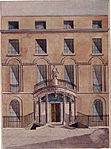South Bank Tower
Buildings and structures in the London Borough of SouthwarkEngvarB from January 2014Office buildings completed in 1972Proposed skyscrapers in LondonRichard Seifert buildings ... and 1 more
Skyscrapers in the London Borough of Southwark

Southbank Tower (formerly South Bank Tower King's Reach Tower until 2013) is a high-rise building in Stamford Street, Southwark, London. It was originally a thirty-storey structure 111 metres (364 ft) high and was completed in 1972, designed by the architect Richard Seifert and built by John Laing. In recent years, the tower has undergone extensive redevelopment and a height increase. The tower is similar in design to Tower 42, which was designed by the same architect.
Excerpt from the Wikipedia article South Bank Tower (License: CC BY-SA 3.0, Authors, Images).South Bank Tower
Hatfields, London Southwark (London Borough of Southwark)
Geographical coordinates (GPS) Address Nearby Places Show on map
Geographical coordinates (GPS)
| Latitude | Longitude |
|---|---|
| N 51.507416666667 ° | E -0.10763888888889 ° |
Address
Enterprise House
Hatfields 1-2
SE1 9PG London, Southwark (London Borough of Southwark)
England, United Kingdom
Open on Google Maps









